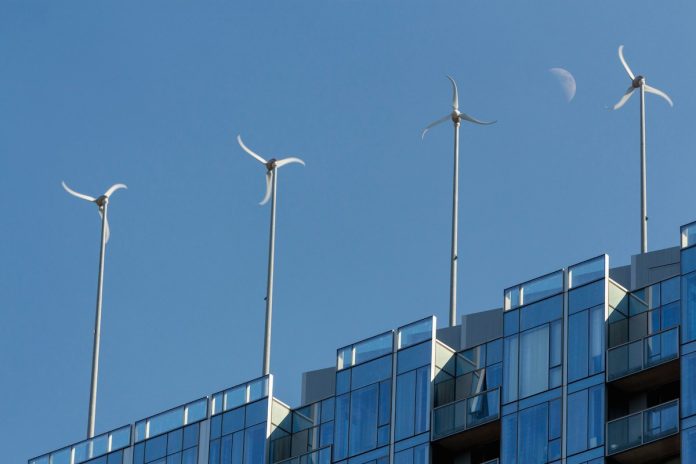Solar power dominates the urban renewable energy conversation, but wind can also generate a significant portion of cities’ energy needs locally. Typically not associated with our cities, sprawling wind farms are the most common and efficient model for wind energy generation. Integrating wind into urban portfolios is challenging–towering horizontal windmills dominating urban airspace are a tough sell and may not sense on a practical basis.
Urban wind energy also faces reliability issues. In contrast to the predictable wind patterns of open and flat terrain, urban environments create chaotic wind patterns. Urban wind patterns are characterized by multi-directional flow and chaotic changes in pressure–turbulence intensity, as it’s called in the industry–is high. Wind patterns in urban environmental are also lower in velocity compared to flat terrain.
The most developed kind of turbine is least suited for urban environments. Horizontal axis wind turbines (HAWTs) are the most prevalent and visible form of wind power. These towering turbines are highly efficient for their cost, but HAWTs are disadvantaged in urban settings.
Horizontal axis turbines preform poorly when exposed to turbulence. To avoid turbulent wind, they are installed at a great height that also exposes them to faster wind speeds. Industrial wind turbines have enormous wing spans lending them large footprints. They are recommended for very open areas or isolated buildings, the opposite of urban.
Sound pollution, vibration, safety, shadow flicker, and aesthetics also present concerns for installing conventional wind turbines in cities. Combined with reduced efficiencies in cities and large footprints, towering bladed towers in urban environments are unappealing and unfeasible.
Making wind energy work in cities
So how can wind energy find a niche in urban environments?
To fit into the urban fold, wind turbines would need to fit into smaller footprints, and operate efficiently under the conditions of urban wind. There are turbines other than the conventional horizontal axis turbine that could make sense for urban deployment. These designs can be scaled down to a smaller profile to fit in urban environments. They are also able to operate in turbulent and lower velocity wind environments by either being able to operate in slower wind speeds and turbulence or adjust urban wind intake to be faster or less turbulent. They have been deployed already, but are limited in scale.
Vertical Axis Wind Turbines
Less developed than their horizontal counterparts, are vertical axis wind turbines (VAWTs). These turbines have two main advantages for urban environments, lower wind startup speeds, and ability to capture wind from any direction. Lower startup speeds allow them to be located near the ground where wind is slower, built in locations where taller structures are prohibited, and placed in strategic locations where wind is funneled and increased in velocity.
The main advantage of VAWTs is the turbine’s blade profile, which doesn’t need to be pointed at the wind. No yaw mechanism is needed to optimize blade orientation. Turbulence is also made a non issue by the design of blade profiles of vertical turbines.
Early vertical axis wind turbine design came in two forms, the Darrieus and Savonius turbines. Both were patented in the 1920s.
- The Darrieus wind turbine looks like an egg beater. It has two or more aerofoil blades that generate lift much like an airplane’s wings do. They generally require an external power source to start turning due to low starting torque and they either have circular, straight, or helicoidal wings.
- The Savonius wind turbines employ cup/scoop like aerofoils. These kind of turbines use drag to spin the rotor. They can self-start at low wind speeds and are excellent for turbulent wind, but they are less efficient than your common Horizontal Axis Wind Turbine.
Some VAWT designs combine the designs with a Savonius turbine between the blades of a Darrieus turbine. This design allows the self-starting drag turbine to start up the life based turbine.

The challenge for VAWTs comes from them having low power coefficients. In an open fiend, a horizontal axis equivalent will perform better. However, if cities are looking for a wind energy solution within urban boundaries, then small vertical axis wind turbines may better fit constricted urban environments.
Diffuser Agumented Wind Turbines
Wind turbines can be modified to have a diffuser that can funnel wind to the turbine, reducing the effect of turbulence and lower wind speeds. Both horizontal and vertical turbines can be augmented with a diffuser.
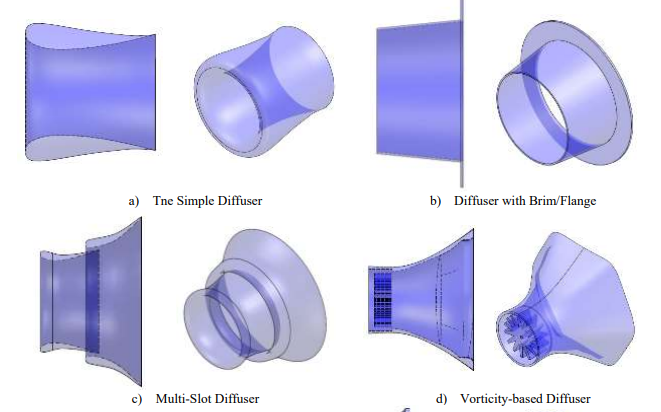
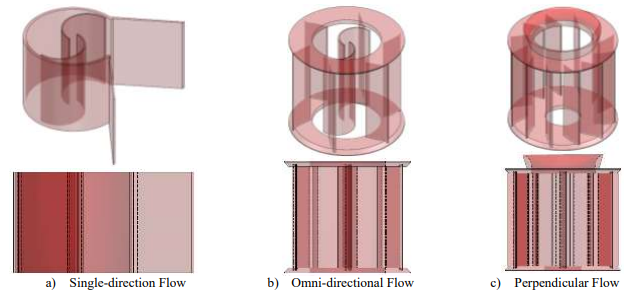
Courtesy of Arouge Agha, Hassam Nasarullah Chaudhry, Fan Wang – DAWT concepts for vertical axis turbines
The Diffuser Augmented Wind Turbine concept can enable for small wind turbine in urban areas. The augmentation compensates for lower wind speeds found in the constrictions placed by urban wind. With a diffuser, horizontal axis turbines are less gated by turbulence, and vertical axis turbines can have their lower power coefficients increased.
Building Integrated and Augmented Wind Turbines
Less turbine design, integrating wind turbines into a building’s design is also an option to bring wind energy in an urban energy portfolio. This involves adjusting building architecture to maximize wind flow for the turbine, just like how a diffuser in a DAWT works to boost it’s turbine’s generation.

The Pearl River Tower in Guangzhou, China is built to maximize wind flow to its four large Savonius vertical access wind turbines. The turbines are strategically placed in the four openings in that tower, which enhances ambient wind speed up to 2.5 times the speed. The inlets also help minimize load effects from wind forces that reduce construction materials and costs.
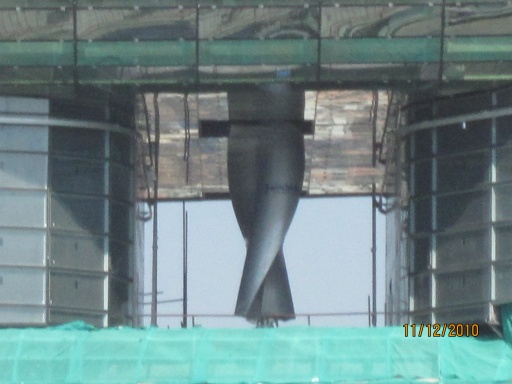
Other design options include placing turbines close to or between buildings. The sheer amount of human impact in a cities create the weather patterns need to making wind energy work. Planned usage or manipulation of the urban heat-island effect is a deciding factor on how viable urban wind energy can be.
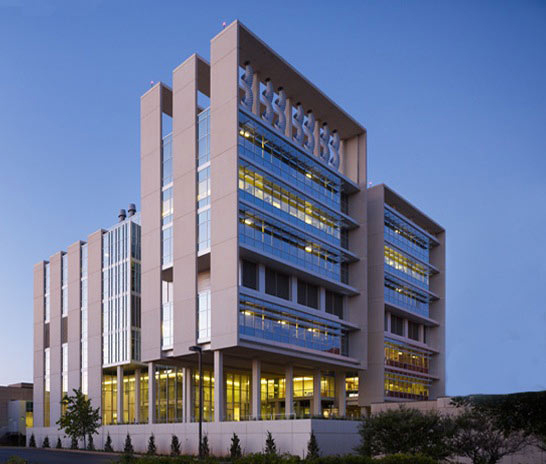
Finding a place for wind
Making wind energy work in Seattle is challenged by the relatively low wind speeds in the region. Wind energy’s nonexistent urban presence in Seattle makes it clear that current conditions don’t cultivate urban wind.
I would like wind to join urban energy portfolios because the monoculture of solar energy isn’t healthy for local energy. Diversity in energy sources locally strengthen the energy security of our population centers. Seattle is the cloudiest major city in the United Sates, reducing the efficacy of local solar panels. Meanwhile, wind energy generation can function during overcast and overnight.
Scale and availability of viable spaces will always limit the capacity of urban wind. The outlined technologies may not make urban wind competitive with a conventional competitive wind farm yet, but they may make a compelling proposition for architects and property owners.
Support of government could help wind energy by identifying urban corridors with wind energy viability, encourage design of the built environment to create corridors for wind energy, and further develop wind turbine technologies. Infrastructure development for energy storage or smart grid improvements would also help expand the niche urban wind fills.
Wind energy faces the same obstacles as solar with our current electrical grid, government support to modernize our grid would help all renewable energy sources. Distributed generation and generation variability are all accommodated for in an intelligent electrical grid. Smart grid applications like microgrids and an energy marketplace could even create positive economic incentives for urban wind energy adoption.
Urban wind fills a minuscule niche right now. In mild Seattle, urban wind will struggle to exist without institutional or infrastructure support. Even with that support, it likely will not become the primary source of energy and we should not over-prioritize it. But wind energy can certainly diversify our urban energy portfolio and boost the resiliency of our system. So let’s give it a spin.
Shaun Kuo is a junior editor at The Urbanist and a recent graduate from the UW Tacoma Master of Arts in Community Planning. He is a urban planner at the Puget Sound Regional Council and a Seattle native that has lived in Wallingford, Northgate, and Lake Forest Park. He enjoys exploring the city by bus and foot.


